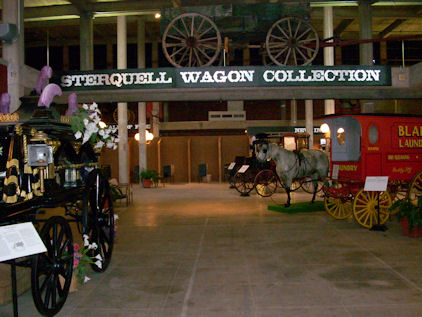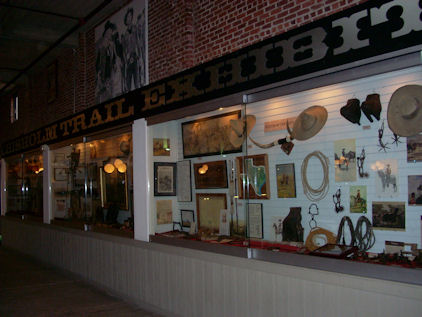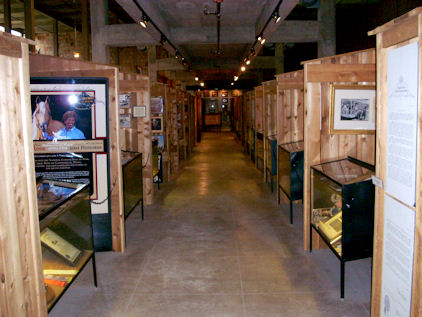In the heart of the Fort Worth Stockyards, in a converted warehouse a few yards from the Visitor’s Center, lies the amazing historical repository known as the Texas Cowboy Hall of Fame.

Despite the name, it’s not merely a place where individual cowboys (and, yes, cowgirls) are lauded for their achievements; it’s also a storehouse of the items that working cowboys actually used in the heyday of the profession. They’ve also got a powerful large collection of wagons used by everyday people back in the 1800s and very early 1900s. Think of it as a hybrid facility that covers everything from frontier Texas life to modern rodeo, with the wagons acting as continuity, and you’re not too far off.

The Texas Cowboy Hall of Fame is housed in a large, cavernous facility, and frankly it has to be; because despite its name, it’s dominated by the large Sterquell Wagon Collection. The cowboy stuff is mostly around the edges. But as I’ve said, the wagon collection isn’t out of place; indeed, it ties together the museum’s disparate elements. The wagons are all lovingly maintained and explained with easy-to-read signage. In addition to the stagecoach, you’ll find farm wagons, personal runabouts, family wagons (the Buick of the 1800s, if you will), a milk wagon, a laundry wagon, and, of course, a fully-stocked chuck wagon, filled with the genuine food tins, condiment bottles, dishes, napkins, and other accoutrements that would have been stored inside the real deal. That wagon’s an education all by itself, and it comes complete with a diorama of rough-looking cowboys chowing down. Elsewhere in the museum is a 1930’s-era Cadillac automobile to ooh <> and ahh at. It doesn’t quite fit, but that’s okay — it’s a neat “wagon” all on its own. Here are some views of what you can expect to see.


Along the walls is where you’ll find the cowpoke-related impedimenta. For example, they’ve got a whole wall devoted to the makers of Justin Boots (the grandiosely named “John Justin Trail of Fame”), which I found especially interesting because, as I’ve mentioned before, I like their Ropers. They’ve also got displays honoring the charros, or Mexican cowboys, who worked early Texas ranches. Metalwork was important to Texas cowboys, as you can tell from this display:

Yes, it’s a rather complete collection of horse bits. If you’re not equestrian-oriented, the bit is the metal thing at the other end of the reins that goes into the horse’s mouth, so you can steer it. How’d you like to have a big piece of metal in your mouth all day, with someone yanking on it constantly? I can’t even stand the taste of my own dental-work.
Here’s an exhibit I have some direct experience with: it’s devoted to the famous Chisholm Trail, along which cattle were driven from Texas north to the railheads and stockyards in Kansas, way back in the day. You can tell how important the Trail was by the size of this exhibit, no?

The trail and its tributaries stretched hundreds of miles, from south Texas on up to the Panhandle and parts north. My association with it came several years ago, when I conducted an archeological survey that included Kimball Bend Park near Cleburne, on state Highway 174 in Bosque County. The park happens to include a portion of the ghost town of Kimball, which was located on the Brazos River at one of the major crossings of the Chisholm Trail. All that’s left today is a few partial structures and associated remains, all of which we duly recorded; but Kimball was a bustling place at the turn of the 20th century. Among other things, there was a brick factory there; if you ever see a brick marked “Bosque,” that’s where it came from. Oddly enough, brick collectors would give you about ten bucks for it, too.
On the far west side of the facility you come to the part that gives the place its name: the displays for the actual inductees into the Texas Cowboy Hall of Fame. (That’s a bit of a misnomer, by the way, since many women and a few couples are honored, too). These are almost exclusively rodeo cowpokes, of course; real cowhands don’t get much attention. The stall-like displays are arranged in a series of long, well-lit interconnected hallways.

Now, unless you’re a rodeo fan, names like Tad Lucas, George Doak, Tuff Hedemann, Lanham Riley, and Pam Minick won’t mean a lot to you, but each is honored here with his or her own area about six feet wide and high. Depending on how recently the inductee was active, you may see televisions with video loops showing footage of their accomplishments, along with items they once owned, relevant newspaper and magazine articles, and in some cases, advertisements they appeared in (this is very common for, say, Wrangler jeans). Among other things, I was fascinated to discover there were Black rodeo cowboys; I hadn’t known that until I perused the Hall. Now, I was aware that African-American working cowboys existed, and that in fact there were quite a few back in the old days, but frankly rodeo doesn’t seem an African-American sport to me. How wrong I am, apparently!
Anyway, there are several rows worth of displays, and it was in the process of growing when I was there in December 2007. Every year they induct several new members; on January 10, 2008, for example, there was a gala ceremony in which new inductees Trevor Brazile, George Doak, Tom Lyons, and Carl Nafzger were honored.
The Texas Cowboy Hall of Fame is located on 128 East Exchange Avenue, inside the stockyards. They’re open every day of the year except December 24-25 and January 1. The hours from Monday to Thursday are 10 AM-6 PM; Friday and Saturday, 10 AM-7 PM; and Sunday, 11 AM-5 PM. The price for admission is a mere $5 for adults, $4 for seniors, and $3 for kids under twelve.
Official website: http://www.texascowboyhalloffame.com/
